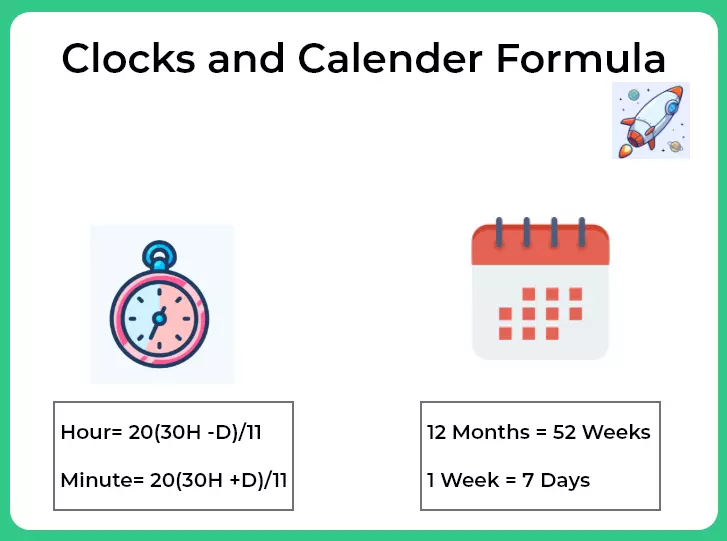Quants Menu
- HCF and LCM
- Number System
- Number Decimals & Fractions
- Surds and Indices
- Divisibility
- Ages
- LCM
- HCF
- Inverse
- Speed Time and Distance
- Work and Time
- Boats and Streams
- Pipes and Cisterns
- Averages
- Allegations and Mixtures
- Ratio and Proportions
- Simple & Compound Interest
- Simple Interest
- Compound Interest
- Percentages
- Profit & Loss
- Successive Discount 1
- Successive Discount 2
- AP GP HP
- Arithmetic Progressions
- Geometric Progressions
- Harmonic Progressions
- Probability
- Permutation & Combination
- Combination
- Circular Permutation
- Geometry
- Heights and Distances
- Perimeter Area and Volume
- Coordinate Geometry
- Venn Diagrams
- Set Theory
- Algebra
- Linear Equations
- Quadratic Equations
- Logarithms
- Clocks
- Calendars
- Clocks and Calendars
- Finding remainder of large powers
PREPINSTA PRIME
Clocks And Calendar Formulas
Best Formulas for Clocks and Calendars
We will be discussing Clocks and Calendar Formulas to help student with variety of formulas that they can use to solve several type of Questions. Here on this page you will get useful key points and formulas for solving Combined Questions of Clock and Calendar.

Clock
Calendar
- Ordinary Year
The year which is not a leap year is called an ordinary year. An ordinary year has 365 days. - Leap Year
A leap year has 366 days.- Every year divisible by 4 is a leap year, if it is not a century.
- Every 4th century is a leap year and no other century is a leap year.

Prime Course Trailer
Get PrepInsta Prime & get Access to all 200+ courses offered by PrepInsta in One Subscription
Important Observations and Formulas of Clock :
- A clock is a complete circle having 360 degrees. It is divided into 12 equal parts i.e. each part:
\frac{360}{12} = 30 - As the minute hand takes a complete round in one hour it covers 360 degrees in 60 min.
Minute Hand covers \frac{360}{60} = 6 \frac{degree}{ minute} - Also, as the hour hand covers just one part out of the given 12 parts in one hour, this implies
Hour Hand covers 300 in 60 min. i.e. 1/2 degree per minute. - Therefore, the relative speed of the minute hand is 6 – \frac{1}{2} = 5\frac{1}{2}degrees
- Every hour, both the hands coincide once. In 12 hours, they will coincide 11 times.
It happens due to only one such incident between 12 and 1’o clock. - The hands are in the same straight line when they are coincident or opposite to each other.
- When the two hands are at a right angle, they are 15-minute spaces apart.
- In one hour, they will form two right angles and in 12 hours there are only 22 right angles. It happens due to right angles formed by the minute and hour hand at 3’o clock and 9’o clock.
- When the hands are in opposite directions, they are 30-minute spaces apart.
- If a clock indicates 9.15, when the correct time is 9, it is said to be 15 minutes too fast. On the other hand, if it indicates 8.45, when the correct time is 9, it is said to be 15 minutes too slow.
- If both the hour hand and minute hand move at their normal speeds, then both the hands meet after 65\frac{5}{11} minutes.
- 22 times in a day, the hands of a clock will be in a straight line but opposite in direction.
- 44 times in a day, the hands of a clock will be straight.
- 44 times in a day, the hands of a clock are at right angles.
- 22 times in a day, the hands of a clock coincide.
30(H- \frac{M}{5}) + \frac{M}{2}degree
30(H-\frac{M}{5}) - \frac{M}{2}degree
Important Observations and Formulas for Calendars:
- A leap year has 366 days
- Every year divisible by 4 is a leap year, if it is not a century.
- Every 4th century is a leap year and no other century is a leap year.
- Counting odd days
1 ordinary year ≡ 365 days ≡ (52 weeks + 1 day)
Hence number of odd days in 1 ordinary year= 1.
1 leap year = 366 days = (52 weeks + 2 days)
Hence number of odd days in 1 leap year= 2.
100 years = (76 ordinary years + 24 leap years)
= (76 x 1 + 24 x 2) odd days
= 124 odd days.
= (17 weeks + 5 days)
= 5 odd days.
Hence number of odd days in 100 years = 5.
Number of odd days in 200 years = (5 x 2) = 10 = 3 odd days
Sample Clock and Calendar Questions with Solution
Question: 1 If your birthday falls on the third Monday of September 2023, on what date will your birthday fall in 2027?
Solution:
In 2023, September 1st is a Friday
The third Monday of September falls on the day after 14 days (2 weeks)
In 2027, September 1st will be a Wednesday (since the days advance by 2 days each year)
Adding 14 days (2 weeks) to Wednesday, we get Wednesday + 14 = Thursday
So, your birthday in 2027 will fall on a Thursday
Question: 2 Sarah set her clock to show 3 o’clock in the afternoon. How many degrees will the hour hand of the clock rotate when the clock shows 8 o’clock at night?
Solution:
From 3 o’clock in the afternoon to 8 o’clock at night is a total of 5 hours.
Since standard clock, the hour hand completes 360°- in 12 hours.
So in 1 hour, it moves 360° / 12 hours = 30° per hour.
Now, for 5 hours:
Degrees rotated by the hour hand = 5 hours × 30° per hour = 150°
So, the hour hand will rotate 150° from 3 o’clock in the afternoon to 8 o’clock at night.
Question: 3 Determine the year in which the calendar will repeat exactly as it was in the year 2015.
Solution:
2015 is a non-leap year.
To find a year with the same calendar, we need to look for a year that is 11 years after 2015
2015 + 11 = 2026
Therefore, the calendar for the year 2026 will be the same as the calendar for the year 2015
Question: 4 Thomas Miller, a curious individual, approaches his mathematics teacher with a question regarding the day on which the 1st of the month will occur, given that the 9th of the month falls on the day just before Sunday.
Solution:
When the 9th of the month falls on the day preceding Sunday, we establish that the 8th of the month is a Saturday.
To determine the day when the 1st of the same month will arrive, we proceed with the following sequence:
- Saturday (8th)
- Sunday (9th)
- Monday (10th)
- Tuesday (11th)
- Wednesday (12th)
- Thursday (13th)
- Friday (14th)
Therefore, if the 9th of the month is positioned just before Sunday, the 1st of the same month will fall on a Friday.
Question: 5 A wager was made between two friends, Harry and Ronald, to determine the probability of randomly selecting a leap year that has 53 Fridays.
Solution:
2/7 in a leap year there are 366 days means 52 weeks and 2days. So already we have 52 Fridays.
Now the rest two days can be:
- (Sunday, Monday)
- (Monday, Tuesday)
- (Tuesday, Wed)
- (Wednesday, Thursdays)
- (Thursday, Friday)
- (Friday, Sat)
- (Sat, Sun)
So, the probability of 53 Fridays = 2/7
Get over 200+ course One Subscription
Courses like AI/ML, Cloud Computing, Ethical Hacking, C, C++, Java, Python, DSA (All Languages), Competitive Coding (All Languages), TCS, Infosys, Wipro, Amazon, DBMS, SQL and others
- Logarithms – Questions | Formulas | How to Solve Quickly | Tricks & Shortcuts
- Clocks – Questions | Formulas | How to Solve Quickly | Tricks & Shortcuts
- Calendars – Questions | Formulas | How to Solve Quickly | Tricks & Shortcuts
Others
- Logarithms –
Questions |
Formulas |
How to Solve Quickly |
Tricks & Shortcuts - Clocks –
Questions |
Formulas |
How to Solve Quickly |
Tricks & Shortcuts - Calendars –
Questions |
Formulas |
How to Solve Quickly |
Tricks & Shortcuts
Others

 Apply For Jobs
Apply For Jobs Get Hiring Updates
Get Hiring Updates




please let me know if there is any video in this course
If you need more videos to watch and learn then go through our Online Course with the given link:
https://prepinsta.com/online-classes/
M=2/11(H1*30+_A) is nice and easy to learn
I Think solving logically and visualizing is better and faster